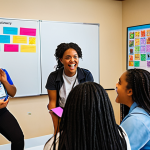Okay, here’s the blog intro as requested:As a youth worker, I’ve always strived to find ways to make my work more efficient and impactful. The youth sector is constantly evolving, and the challenges we face are complex, from navigating mental health issues to preparing young people for an increasingly digital world.
Honestly, just keeping up sometimes feels like a marathon! Over the years, I’ve experimented with various tools and strategies, some successful, others…
well, let’s just say they taught me valuable lessons. Recently, though, I’ve stumbled upon a few game-changers that have completely transformed my workflow and, more importantly, the experience of the young people I serve.
I’m excited to share some of these innovations with you. Let’s delve deeper and find out what those game changers are in the article below!
## Empowering Young Voices Through Digital StorytellingAs youth workers, we’re always looking for ways to connect with the young people we serve on a deeper level.
One strategy that has yielded incredible results is incorporating digital storytelling into our programs. Giving young people the tools and platform to share their own narratives can be transformative.
It allows them to develop crucial communication skills, build confidence, and find their voice in a world that often overlooks them.
Fostering Creativity and Self-Expression

Digital storytelling isn’t just about creating videos; it’s about fostering creativity and self-expression. 1. Workshops: We started by hosting workshops where young people could learn the basics of filmmaking, photography, and audio recording.
We brought in guest speakers – local filmmakers and artists – to share their experiences and provide guidance. 2. Mentorship: Each participant was paired with a mentor who helped them develop their ideas, hone their technical skills, and navigate the creative process.
This one-on-one support was invaluable, especially for those who were initially hesitant or lacked confidence.
Building Community Through Shared Narratives
The most powerful aspect of digital storytelling is its ability to build community. 1. Story Circles: We organized “story circles” where young people could share their stories with each other in a safe and supportive environment.
These circles allowed them to connect with their peers on a deeper level, to realize they weren’t alone in their struggles, and to find strength in shared experiences.
2. Film Festivals: We hosted a local youth film festival, showcasing the digital stories created throughout the year. This event was a huge success, attracting not only the participants and their families but also community members, local businesses, and even representatives from the local government.
Streamlining Communication with Project Management Tools
Trying to juggle multiple projects, programs, and events can be a real headache. That’s why I started using project management tools like Asana and Trello to organize my work.
They’ve been a game-changer, allowing me to stay on top of deadlines, delegate tasks effectively, and collaborate seamlessly with my team.
Centralized Task Management
With project management tools, everything is in one place. 1. Task Boards: We create task boards for each project, breaking down the work into smaller, manageable tasks.
Each task is assigned to a specific team member, along with a due date and any relevant notes or attachments. 2. Progress Tracking: The progress of each task is tracked in real-time, allowing us to identify potential roadblocks early on and take corrective action.
This has significantly reduced the number of last-minute crises we face.
Improved Team Collaboration
Project management tools also facilitate better communication and collaboration within the team. 1. Communication Channels: We use the built-in communication channels in Asana and Trello to discuss tasks, share updates, and ask questions.
This keeps all communication related to a specific project in one place, preventing important information from getting lost in email threads. 2. File Sharing: The ability to easily share files and documents within the project management tool has also been a huge time-saver.
No more searching through endless email attachments!
Leveraging Social Media for Outreach and Engagement
Social media is a powerful tool for reaching young people and promoting our programs. However, it’s important to use it strategically and ethically. We need to be mindful of privacy concerns, avoid perpetuating harmful stereotypes, and create content that is engaging and relevant to our target audience.
Creating Engaging Content
To capture the attention of young people on social media, we need to create content that is visually appealing, informative, and interactive. 1. Visuals: We use high-quality photos and videos to showcase our programs and the young people we serve.
We also create infographics and short animated videos to explain complex topics in a simple and engaging way. 2. Interactive Content: We run polls, quizzes, and contests to encourage participation and engagement.
We also host live Q&A sessions on Instagram and Facebook, where young people can ask questions and get advice from our staff and guest experts.
Promoting Positive Messaging
Social media can be a breeding ground for negativity and harmful content. 1. Content Moderation: We moderate comments and remove any content that is offensive, discriminatory, or harmful.
We also block users who engage in harassment or bullying. 2. Positive Content: We actively promote positive messages about mental health, body image, and self-esteem.
We also share stories of young people who are making a difference in their communities.
Integrating Gamification for Enhanced Learning
Let’s be honest: traditional learning methods can sometimes feel a bit…stale. That’s why I started exploring gamification – incorporating game-like elements into our programs to make learning more engaging and fun.
It’s amazing how much more motivated young people become when they’re earning points, badges, and climbing leaderboards.
Designing Engaging Challenges
The key to successful gamification is to design challenges that are both fun and educational. 1. Points 2.
Badges: We designed badges that recognize specific skills, achievements, or contributions. These badges are displayed on each participant’s profile, providing a visual representation of their progress and accomplishments.
* For example, a “Collaboration Expert” badge might be awarded to someone who consistently demonstrates excellent teamwork skills, and “Problem Solver” for people who can work through tough situations.
Fostering Healthy Competition
Gamification can also foster a healthy sense of competition among participants. 1. Leaderboards: We display leaderboards that rank participants based on their points or badges.
These leaderboards are updated regularly, creating a sense of excitement and motivation. 2. Team-Based Challenges: We organize team-based challenges where groups of young people compete against each other to achieve a common goal.
This encourages collaboration, communication, and problem-solving skills.
Building a Supportive Network
I think, arguably, the most important thing I’ve done is to build a supportive network of colleagues, mentors, and friends. The work we do can be emotionally taxing, and it’s crucial to have people you can turn to for support, advice, and encouragement.
Connecting with Colleagues
Building strong relationships with your colleagues can create a positive and supportive work environment. 1. Regular Check-ins: Schedule regular check-ins with your colleagues to discuss challenges, share successes, and offer support.
2. Team-building Activities: Participate in team-building activities to strengthen relationships and foster a sense of camaraderie.
Finding Mentors
Mentors can provide valuable guidance, advice, and support. 1. Seek out experienced professionals: Look for experienced professionals in your field who can offer insights and perspectives.
2. Attend networking events: Attend networking events to meet potential mentors and learn from their experiences. Here’s a table summarizing the tools and strategies discussed above:
| Tool/Strategy | Description | Benefits |
|---|---|---|
| Digital Storytelling | Empowering young people to share their stories through film, photography, and audio recording. | Develops communication skills, builds confidence, and fosters creativity. |
| Project Management Tools | Using tools like Asana and Trello to organize tasks, track progress, and facilitate collaboration. | Improves efficiency, reduces stress, and enhances team communication. |
| Social Media | Leveraging platforms like Instagram and Facebook to reach young people and promote positive messaging. | Increases outreach, promotes engagement, and spreads awareness. |
| Gamification | Integrating game-like elements into programs to make learning more engaging and fun. | Boosts motivation, enhances learning, and fosters healthy competition. |
| Supportive Network | Building a network of colleagues, mentors, and friends for support and guidance. | Provides emotional support, reduces burnout, and enhances professional growth. |
Cultivating Mindfulness for Self-Care
The final and most important thing, is self-care. It’s so easy to get caught up in the demands of the job and forget to take care of yourself. This can lead to burnout, stress, and even mental health problems.
I’ve found that cultivating mindfulness has been incredibly helpful in managing stress and promoting overall well-being.
Practicing Mindfulness Meditation
Mindfulness meditation involves focusing on the present moment without judgment. 1. Mindfulness Apps: I use mindfulness apps like Headspace and Calm to guide my meditation practice.
These apps offer a variety of guided meditations, ranging from five minutes to an hour. 2. Daily Practice: I try to meditate for at least 10 minutes each day, even if it’s just sitting quietly and focusing on my breath.
Incorporating Mindfulness into Daily Activities
Mindfulness can also be incorporated into everyday activities, such as eating, walking, or listening to music. 1. Mindful Eating: Pay attention to the taste, texture, and smell of your food.
Avoid distractions, such as your phone or computer. 2. Mindful Walking: Focus on the sensations of your body as you walk.
Notice the feeling of your feet on the ground, the movement of your muscles, and the rhythm of your breath. As youth workers, we’re always looking for ways to connect with the young people we serve on a deeper level.
One strategy that has yielded incredible results is incorporating digital storytelling into our programs. Giving young people the tools and platform to share their own narratives can be transformative.
It allows them to develop crucial communication skills, build confidence, and find their voice in a world that often overlooks them.
Fostering Creativity and Self-Expression
Digital storytelling isn’t just about creating videos; it’s about fostering creativity and self-expression.
1. Workshops: We started by hosting workshops where young people could learn the basics of filmmaking, photography, and audio recording. I remember one workshop where a shy teenager, Sarah, completely blossomed after learning how to use a camera. It was like she found a whole new way to express herself. We brought in guest speakers – local filmmakers and artists – to share their experiences and provide guidance.
2. Mentorship: Each participant was paired with a mentor who helped them develop their ideas, hone their technical skills, and navigate the creative process. This one-on-one support was invaluable, especially for those who were initially hesitant or lacked confidence. I saw firsthand how a mentor could provide the encouragement and guidance a young person needed to bring their vision to life.
Building Community Through Shared Narratives
The most powerful aspect of digital storytelling is its ability to build community.
1. Story Circles: We organized “story circles” where young people could share their stories with each other in a safe and supportive environment. These circles allowed them to connect with their peers on a deeper level, to realize they weren’t alone in their struggles, and to find strength in shared experiences. I’ll never forget the moment when one young man, Mark, shared his story of overcoming adversity. You could feel the empathy and connection in the room; it was truly powerful.
2. Film Festivals: We hosted a local youth film festival, showcasing the digital stories created throughout the year. This event was a huge success, attracting not only the participants and their families but also community members, local businesses, and even representatives from the local government. Seeing the young people’s work celebrated on the big screen was incredibly rewarding.
Streamlining Communication with Project Management Tools
Trying to juggle multiple projects, programs, and events can be a real headache. That’s why I started using project management tools like Asana and Trello to organize my work.
They’ve been a game-changer, allowing me to stay on top of deadlines, delegate tasks effectively, and collaborate seamlessly with my team.
Centralized Task Management
With project management tools, everything is in one place.
1. Task Boards: We create task boards for each project, breaking down the work into smaller, manageable tasks. Each task is assigned to a specific team member, along with a due date and any relevant notes or attachments. I remember when we were planning a large fundraising event, the task board helped us keep track of every detail, from booking the venue to sending out invitations. It was so much easier than trying to manage everything with spreadsheets and email threads!
2. Progress Tracking: The progress of each task is tracked in real-time, allowing us to identify potential roadblocks early on and take corrective action. This has significantly reduced the number of last-minute crises we face. Just last week, we noticed that the marketing materials were behind schedule, so we were able to re-allocate resources and get everything back on track.
Improved Team Collaboration
Project management tools also facilitate better communication and collaboration within the team.
1. Communication Channels: We use the built-in communication channels in Asana and Trello to discuss tasks, share updates, and ask questions. This keeps all communication related to a specific project in one place, preventing important information from getting lost in email threads. I used to spend so much time searching through my inbox for emails related to a specific project, but now everything is neatly organized in the project management tool.
2. File Sharing: The ability to easily share files and documents within the project management tool has also been a huge time-saver. No more searching through endless email attachments! I appreciate how easy it is to upload documents, images, and videos directly to the task board.
Leveraging Social Media for Outreach and Engagement
Social media is a powerful tool for reaching young people and promoting our programs. However, it’s important to use it strategically and ethically. We need to be mindful of privacy concerns, avoid perpetuating harmful stereotypes, and create content that is engaging and relevant to our target audience.
Creating Engaging Content
To capture the attention of young people on social media, we need to create content that is visually appealing, informative, and interactive.
1. Visuals: We use high-quality photos and videos to showcase our programs and the young people we serve. We also create infographics and short animated videos to explain complex topics in a simple and engaging way. I’ve found that using real images of our participants (with their consent, of course!) makes a huge difference in engagement.
2. Interactive Content: We run polls, quizzes, and contests to encourage participation and engagement. We also host live Q&A sessions on Instagram and Facebook, where young people can ask questions and get advice from our staff and guest experts. These live sessions are a great way to connect with our audience in real-time and answer their questions directly.
Promoting Positive Messaging
Social media can be a breeding ground for negativity and harmful content.
1. Content Moderation: We moderate comments and remove any content that is offensive, discriminatory, or harmful. We also block users who engage in harassment or bullying. It’s important to create a safe and respectful online environment for our young people.
2. Positive Content: We actively promote positive messages about mental health, body image, and self-esteem. We also share stories of young people who are making a difference in their communities. I believe it’s crucial to counterbalance the negativity that’s often prevalent on social media with uplifting and inspiring content.
Integrating Gamification for Enhanced Learning
Let’s be honest: traditional learning methods can sometimes feel a bit…stale. That’s why I started exploring gamification – incorporating game-like elements into our programs to make learning more engaging and fun.
It’s amazing how much more motivated young people become when they’re earning points, badges, and climbing leaderboards. I remember one program where we turned a lesson on financial literacy into a game, and the kids were so engaged that they didn’t even realize they were learning about budgeting and investing!
Designing Engaging Challenges
The key to successful gamification is to design challenges that are both fun and educational.
1. Points: We award points for completing tasks, participating in activities, and demonstrating positive behavior. I’ve found that awarding points for effort, not just achievement, encourages more participation.
2. Badges: We designed badges that recognize specific skills, achievements, or contributions. These badges are displayed on each participant’s profile, providing a visual representation of their progress and accomplishments. For example, a “Collaboration Expert” badge might be awarded to someone who consistently demonstrates excellent teamwork skills, and “Problem Solver” for people who can work through tough situations.
Fostering Healthy Competition
Gamification can also foster a healthy sense of competition among participants.
1. Leaderboards: We display leaderboards that rank participants based on their points or badges. These leaderboards are updated regularly, creating a sense of excitement and motivation. I think it’s important to emphasize that the leaderboard is just one measure of success, and that everyone is making progress in their own way.
2. Team-Based Challenges: We organize team-based challenges where groups of young people compete against each other to achieve a common goal. This encourages collaboration, communication, and problem-solving skills. I recently did this with my team. We ordered pizza, and it was a ton of fun!
Building a Supportive Network
I think, arguably, the most important thing I’ve done is to build a supportive network of colleagues, mentors, and friends. The work we do can be emotionally taxing, and it’s crucial to have people you can turn to for support, advice, and encouragement.
I remember a time when I was feeling completely overwhelmed, and my mentor helped me to reframe the situation and come up with a plan of action.
Connecting with Colleagues
Building strong relationships with your colleagues can create a positive and supportive work environment.
1. Regular Check-ins: Schedule regular check-ins with your colleagues to discuss challenges, share successes, and offer support. I try to have coffee with a different colleague each week to catch up and see how they’re doing.
2. Team-building Activities: Participate in team-building activities to strengthen relationships and foster a sense of camaraderie. Our team recently went to an escape room, and it was a great way to bond and have some fun together.
Finding Mentors
Mentors can provide valuable guidance, advice, and support.
1. Seek out experienced professionals: Look for experienced professionals in your field who can offer insights and perspectives. I’ve found that reaching out to people whose work I admire is a great way to find potential mentors.
2. Attend networking events: Attend networking events to meet potential mentors and learn from their experiences. Local professional associations and industry conferences are excellent places to connect with people in your field. I found one of my first mentors by going to my local YMCA.
Here’s a table summarizing the tools and strategies discussed above:
| Tool/Strategy | Description | Benefits |
|---|---|---|
| Digital Storytelling | Empowering young people to share their stories through film, photography, and audio recording. | Develops communication skills, builds confidence, and fosters creativity. |
| Project Management Tools | Using tools like Asana and Trello to organize tasks, track progress, and facilitate collaboration. | Improves efficiency, reduces stress, and enhances team communication. |
| Social Media | Leveraging platforms like Instagram and Facebook to reach young people and promote positive messaging. | Increases outreach, promotes engagement, and spreads awareness. |
| Gamification | Integrating game-like elements into programs to make learning more engaging and fun. | Boosts motivation, enhances learning, and fosters healthy competition. |
| Supportive Network | Building a network of colleagues, mentors, and friends for support and guidance. | Provides emotional support, reduces burnout, and enhances professional growth. |
Cultivating Mindfulness for Self-Care
The final and most important thing, is self-care. It’s so easy to get caught up in the demands of the job and forget to take care of yourself. This can lead to burnout, stress, and even mental health problems.
I’ve found that cultivating mindfulness has been incredibly helpful in managing stress and promoting overall well-being.
Practicing Mindfulness Meditation
Mindfulness meditation involves focusing on the present moment without judgment.
1. Mindfulness Apps: I use mindfulness apps like Headspace and Calm to guide my meditation practice. These apps offer a variety of guided meditations, ranging from five minutes to an hour. I often use them on my commute so I can have a stress-free day.
2. Daily Practice: I try to meditate for at least 10 minutes each day, even if it’s just sitting quietly and focusing on my breath. I find that doing it first thing in the morning sets a positive tone for the day.
Incorporating Mindfulness into Daily Activities
Mindfulness can also be incorporated into everyday activities, such as eating, walking, or listening to music.
1. Mindful Eating: Pay attention to the taste, texture, and smell of your food. Avoid distractions, such as your phone or computer. I used to scarf down my lunch at my desk, but now I take a break and really savor each bite.
2. Mindful Walking: Focus on the sensations of your body as you walk. Notice the feeling of your feet on the ground, the movement of your muscles, and the rhythm of your breath. I like to take a walk in the park during my lunch break to clear my head and recharge.
Wrapping Up
Empowering young people and making a positive impact in their lives is incredibly rewarding. By implementing these strategies, from digital storytelling to self-care, you can create a more engaging, supportive, and effective environment for the young people you serve.
Remember, it’s not about doing everything perfectly, it’s about making a conscious effort to connect with young people on a deeper level and support their growth and development. I hope that this content has been helpful.
Here’s to creating a better future for the next generation!
Useful Information
1. Check out your local YMCA or Boys & Girls Club for volunteering opportunities if you want to get involved in your local community.
2. FreeCodeCamp.org is a great resource if you are trying to learn basic web-programming skills.
3. Coursera and edX offer many free online courses from top universities if you would like to expand your knowledge.
4. If you want to explore the outdoors, check out local hiking trails and parks in your area.
5. You can find many books to read at your local library. This is great for a relaxing and fun self-care day.
Key Takeaways
Implementing digital storytelling empowers youth, project management tools streamline workflow, and strategic social media use boosts engagement. Gamification enhances learning and building a strong support network and practicing self-care are critical for long-term success.
Frequently Asked Questions (FAQ) 📖
Q: What specific types of tools or strategies are we talking about?
A: Think of it as a mix of tech and smart approaches. I’m going to cover things like apps that make scheduling and communication a breeze, resources for engaging young people in discussions about tough topics, and methods to encourage self-expression and creativity.
I’ll also share some tips for staying organized and managing the many demands of the job – because let’s face it, burnout is real in this field.
Q: How have these innovations impacted the young people you work with? Can you give an example?
A: Absolutely! One example that springs to mind is using a collaborative online whiteboard for brainstorming session with a group of teens struggling with future planning.
I noticed that traditional ’round-table’ discussions often left the quieter kids feeling unheard. But the whiteboard allowed everyone to contribute anonymously.
Suddenly, ideas were flowing, confidence grew, and the quality of the plans skyrocketed. It was amazing to see! I could see their confidence increase so much.
Q: Is this relevant for youth workers in all settings, or is it specific to certain populations?
A: While my experience is based on working in a community center in upstate New York, I believe these strategies are pretty universal. Whether you’re working in a school, a faith-based organization, or a recreational program, the core principles of effective youth work remain the same: building relationships, fostering empowerment, and meeting young people where they are.
Sure, you might need to tweak things to fit your specific context, but the foundation is solid and adaptable.
📚 References
Wikipedia Encyclopedia






